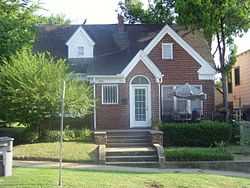Swan Lake (Tulsa)
|
Swan Lake Historic District | |
 | |
|
1930 Orcutt Duplex in Swan Lake | |
| Location | Tulsa, OK |
|---|---|
| Coordinates | 36°08′08″N 95°58′12″W / 36.13556°N 95.97000°WCoordinates: 36°08′08″N 95°58′12″W / 36.13556°N 95.97000°W |
| Built | 1910 |
| Architectural style | Various |
| Governing body | Private |
| NRHP Reference # | 98000140 [1] |
| Added to NRHP | February 20, 1998 |
Swan Lake is a historic district in Tulsa, Oklahoma. Its borders consist of 15th Street to the North, Utica Street to the East, 21st Street to the South, and Peoria Avenue to the west.[2] It was the site of an amusement park in the early Twentieth Century, but is now notable for the number and architectural variety of houses and apartment buildings constructed in the 1920s and 1930s. In 2011, the American Planning Association named Swan Lake as a Top Ten Great Neighborhood.[3]
History
At the beginning of the Twentieth Century, spring-fed Orcutt Lake was the watering hole for a ranch belonging to Colonel A. D. Orcutt, a member of Oklahoma’s first legislature. In 1908, a group of developers led by Colonel Orcutt’s son, Samuel A. Orcutt, purchased 25 acres (100,000 m2) in Orcutt Addition to build a park and an artificial lake. The amusement park, built by the lake in 1910, marked the end of the trolley line. Other park facilities included an enclosed dance pavilion, a swimming pool, and, later, a $7,600 roller-coaster. By 1917, Orcutt Lake Amusement Park had become a residential area and was renamed Swan Lake.[2] A streetcar line from downtown terminated at the amusement park. The park facilities are long gone, replaced by imposing mansions during the 1920s, but the lake remains to the present.
Description
Swan Lake is the focal point of the district of the same name. Two-story houses built around the lake from 1919 to the present represent a variety of architectural styles including Spanish, Georgian Revival and vernacular interpretations honoring the swan. The remainder of the neighborhood is similar in scale, containing bungalows, two-story houses, quadruplexes and six-plexes of stone, clapboard and stucco. The Swan Lake area has more two- and three-story, 1920 to 1930 multi-family apartments and duplexes than any other residential area in Tulsa. The district includes the commercial area on 15th Street.[4]
The neighborhood of Swan lake was designed and laid out in a smaller than normal street grid system. This design identified from the beginning a desire for an enhance focus on pedestrian traffic and an indirect focus on neighborly community interaction. Supporting this idea is the quantity of community organization and community activities that are prevalent year round. Such a community involvement identifies a true connection between the neighborhood and the citizens that call it home.
- Organized in 1983, Swan Lake Neighborhood Association launched a successful campaign (1992) to list neighborhood in the National Register of Historic Places (1998)[5]
- Tulsa Parks and Swan Lake Waterfowl Society partner to ensure viability of resident swans and other riparian birds. Society cares for and feeds waterfowl; park staff maintains shore habitat.[5]
- Neighborhood events such as September block party, Halloween parade and costume contest, November's "Lights on Swan Lake" foster community spirit and public participation.[5] Such a rich history of community involvement has created a neighborhood of natural and manmade beauty. From the early beginning there has been a focus on creating an atmosphere of interaction between people and nature. Currently a hot spot for bird watches the 4 acre Swan Lake Park provides walking paths, ornamental stone fountains, thematic sculptures, and seasonal Lighting provides a perfect area for relaxation. Also in the area are two important sculptures that capture the essence of the park
- The larger-than-life bronze of a trumpeter swan in-flight located at park entrance.[5]
- "Enchantment," a boy with a swan, relocated from 1934 Chicago World's Fair.[5]
Swan Lake was placed on the National Register of Historic Places on February 20, 1998 under National Register criteria A and C. Its NRIS number is 98000140.[2]
Great American Place
The United States is rich in culturally historic neighborhoods sometimes in plain sight or hidden among the many streets of the many large cities across the country. Each significant in their own way to their own communities yet some have been identified as “Great Places in America: Neighborhoods” by the American Planning Association. The American Planning Association (APA) is an independent, not-for-profit organization that supports and advocates community planning threw educational and citizen empowerment. The Swan Lake Neighborhood has been identified along with nine other neighborhoods as 2011’s “Great Places In America: Neighborhoods”. An APA program celebrates communities with a true sense of place, culture and historical interest, community involvement, and vision that set the standard of excellence. It is a great honor for this neighborhood to be identified as an area of exemplary character, planning, and quality by the national organization. The Swan Lake Neighborhood is a community that should be celebrated and learned from to help spread this high standard across the country.
Marquette School
According to the Tulsa Preservation Commission, Marquette School, the parish school for Christ the King Catholic Church, is a contributing resource for the Swan Lake Historical District. The school is at 1519 South Quincy Avenue.[6]
References
- ↑ "National Register Information System". National Register of Historic Places. National Park Service. 2007-01-23.
- ↑ 2.0 2.1 2.2 Tulsa Preservation Commission. "Swan Lake Historic District." Retrieved November 20, 2011.
- ↑ DeCort, Amanda. Tulsa Preservation Commission. "Swan Lake Named a Top 10 Great Neighborhood by APA." October 3, 2011. Retrieved December 11, 2011.
- ↑ "Tulsa Preservation Commission".
- ↑ 5.0 5.1 5.2 5.3 5.4 "Great Places in America: Neighborhoods". American Planning Association. Retrieved 2012-12-16.
- ↑ Tulsa Preservation Commission. "Marquette School." Retrieved November 20, 2011.
External links
| |||||||||||
| ||||||||||||||||||||